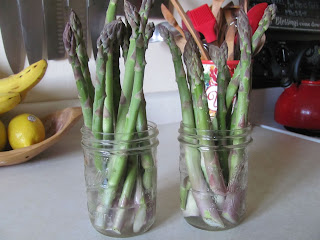As an avid Indiana gardener, I’m always a little entertained
when I read recipe ideas or watch cooking shows featuring seasonal recipes in
April. They include things like parmesan roasted asparagus, buttered peas,
radishes and salad greens, and fresh strawberries! Yum!
Buying local food and from farmers markets is super trendy
right now, so a lot of the articles I’ve read say things like, “Just go down to
your local farmer’s market and look for the freshest asparagus, or, “Buy
strawberries now, because they are in season!”
But here’s the thing. These things may be locally available
in other parts of the country, but they are definitely not growing here in
Indiana yet. If you are shopping for asparagus, or peas, or strawberries at the
grocery store, they have been shipped across the country, not grown in Indiana!
 |
| April garden beds in Indiana |
When I was working at the farmer’s market last year, I saw a
lot of this. There were all kinds of veggies and fruits people thought that us
growers should have because they could find it “seasonally available” at the
grocery, and were disappointed to find they weren’t available yet at our market.
In fact, most Indiana farm markets won’t even open until May
because there just really isn’t much to sell yet. (The exception to this
would be local growers who can afford a heated greenhouse to get a head
start on vegetables.)
So what is actually growing right now? If you truly wanted
to eat in season and locally, what would you find?
In our garden you would find…
Run-up Turnip Greens. We planted these late last summer and
they overwinter and pop up again in early spring. The small leaves are tender with
a slight spiciness to them. My hubby and I will use them for a salad (nothing
like eating fresh greens when you have eaten home canned and frozen vegetables
all winter…sooooo good!) and my kids will tolerate the slight bitter leaves in
soups and stews.
 |
| Curly Leaf Kale |
 |
| Red Russian Kale |
Kale- another hearty green that overwinters in the garden
well! We planted this kale last fall and it started to thrive again in early
April. The frosts make this normally bitter green sweeter, so it’s definitely a
special treat if you can find it or grow it in the spring. Later varieties you
find throughout the summer won’t be nearly as tasty and a lot more bitter once
it starts to heat up outside.
Spring garlic- We don’t usually pick or eat our garlic in
the spring unless we are desperate for fresh garlic because the bulbs are
still small. But spring garlic can be found at markets. It is milder in flavor than summer garlic. You can also
find garlic scapes (also known as garlic chives) which are the tender shoots
that garlic plants put up in the spring. These look like chives, but have a
garlic flavor and are absolutely delicious to cook with.
Spring Onions- we grow these Egyptian Walking
Onions, which are amazing! They overwinter and you can see that they are
already vibrant and ready to eat! The whole plant of this variety can be eaten,
the roots like a normal onion and the tops as green onions.
Herbs- we have tarragon, oregano, mint, lemon balm, sage,
and cilantro springing up in our garden. While herbs don't constitute as a meal by any means, they do add great flavor to your food!
And don’t worry, if you are dying to try parmesan roasted
asparagus or buttered peas, they are on their way! They are starting to push up
through the ground and should be making an appearance in May!


























